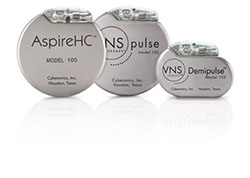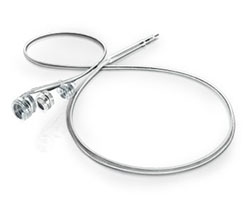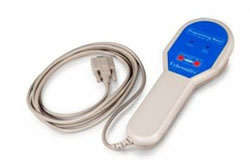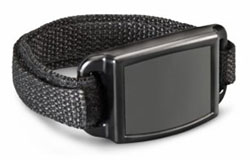Overview
The vagus nerve is one of 12 pairs of cranial nerves that originate in the brain and is part of the autonomic nervous system, which controls involuntary body functions. The nerve passes through the neck as it travels between the chest and abdomen and the lower part of the brain. It is connected to motor functions in the voice box, diaphragm, stomach and heart and sensory functions in the ears and tongue. It is connected to both motor and sensory functions in the sinuses and esophagus.
Vagus nerve stimulation (VNS) sends regular, mild pulses of electrical energy to the brain via the vagus nerve, through a device that is similar to a pacemaker. There is no physical involvement of the brain in this surgery and patients cannot generally feel the pulses. It is important to keep in mind that VNS is a treatment option limited to select individuals with epilepsy or treatment-resistant depression.
Individuals with any of the following criteria may potentially be unsuitable candidates for VNS:
- One vagus nerve
- Receiving other concurrent forms of brain stimulation
- Heart arrhythmias or other heart abnormalities
- Dysautonomias (abnormal functioning of the autonomic nervous system)
- Lung diseases or disorders (shortness of breath, asthma, etc.)
- Ulcers (gastric, duodenal, etc.)
- Vasovagal syncope (fainting)
- Pre-existing hoarseness
TREATMENT + CARE
VNS Implantation
This procedure, performed by a neurosurgeon, usually takes about 45-90 minutes with the patient most commonly under general anesthesia. It is usually performed on an outpatient basis. As with all surgeries, there is a small risk of infection. Other surgical risks of VNS include inflammation or pain at the incision site, damage to nearby nerves and nerve constriction.
The procedure requires two small incisions. The first one is made on the upper left side of the chest where the pulse generator is implanted (Pulse Generator, Figure 1). A second incision is made horizontally on the left side of the lower neck, along a crease of skin. This is where the thin, flexible wires that connect the pulse generator to the vagus nerve are inserted (Lead, Figure 2).

Pulse Generator (Figure 1)

Lead (Figure 2)*
The device or implant is a flat, round piece of metal that measures about an inch and a half (4 centimeters) across and 10-13 mm thick, depending on the model used (Pulse Generator, Figure 1). Newer models may be somewhat smaller. The stimulator contains a battery, which can last from one to 15 years. When the battery is low, the stimulator is replaced with a less invasive procedure which requires only opening the chest wall incision.
The stimulator is most commonly activated two to four weeks after implantation, although in some cases it may be activated in the operating room at the time of implantation. The treating neurologist programs the stimulator in his or her office with a small hand-held computer, programming software and a programming wand (Programming Wand, Figure 3). The strength and duration of the electrical impulses are programmed. The amount of stimulation varies by case but is usually initiated at a low level and slowly increased to a suitable level for the individual. The device runs continuously and is programmed to turn on and shut off for specific periods of time — for example, 30 seconds on and 5 minutes off.
Patients are provided with a handheld magnet (Magnet Bracelet, Figure 4) to control the stimulator at home (which must be activated by the physician to magnet mode). When the magnet is swept over the pulse generator site, extra stimulation is delivered regardless of the treatment schedule. Holding the magnet over the pulse generator will turn the stimulation off while the magnet is in position. Removing it will resume the stimulation cycle. All maneuvers performed with the magnet can be done by the patient, family members, friends or caregivers.

Programming Wand (Figure 3)*

Magnet Bracelet (Figure 4)*
Side effects are most commonly related to stimulation and usually improve over time. These may include any of the following:
- Hoarseness
- Increased coughing
- Changes in voice/speech
- General pain
- Throat or neck pain
- Throat or larynx spasms
- Headache
- Insomnia
- Indigestion
- Muscle movements or twitching related to the stimulation
- Nausea or vomiting
- Impaired sense of touch
- Prickling or tingling of the skin
Of these, hoarseness, coughing, throat tickling and shortness of breath are the most common and are usually temporary.
Patient Tips/Guidelines
If you have received VNS, you should monitor your condition and overall health closely. If any of the following occur, call your doctor right away:
- Constantly hoarse voice
- Stimulation which becomes painful or irregular
- Stimulation which causes choking, breathing or swallowing difficulties or a change in heart rate
- Changes in your level of consciousness, such as increased drowsiness
- Signs that the pulse generator may not be stimulating properly or that the battery is depleted (the device stops working)
- Any new or unusual changes related specifically to the stimulation
In addition, you should call your physician before you undergo any medical tests that might affect, or be affected by VNS, such as magnetic resonance imaging (MRI), or before you have any other medical devices implanted.
Epilepsy
The Food and Drug Administration (FDA) approved VNS as a seizure treatment in 1997. VNS may be considered as a treatment option in patients who have tried two or more anti-epileptic drugs (AEDs) without adequate control of their seizures or in patients who have not responded to AEDs and cannot undergo brain surgery. It is important to keep in mind that VNS is used in conjunction with AEDs, not instead of them. In addition, VNS is considered a palliative procedure which can effectively improve seizure control but does not generally produce complete seizure-freedom. VNS can take up to two years to have an effect on a patient’s seizures. If VNS proves effective, it may enable a patient to decreases dosages of AEDs over time.
The goal of VNS is to reduce the number, length and severity of seizures. VNS may also reduce the time it takes to recover after a seizure. However, VNS is not successful in all patients. The success of this treatment differs — some patients report less frequent seizures, others report a slight reduction, while some patients do not respond at all.
The following results have been noted in select patients with epilepsy:
- Less severe or shorter seizures
- Better recovery after seizures (postictal period)
- Improved sense of well-being
- Improved mood
- Improved alertness, memory and cognitive skills
- Fewer emergency room visits
For people with warnings (auras) before their seizures, activating the stimulator with the magnet when the warning occurs may help shorten or even stop the seizures.
Treatment-Resistant Depression
Soon after VNS was approved by the FDA as a seizure treatment, reports indicated a possible decrease in depression symptoms in patients who had the device implanted for seizure control. Like electroconvulsive therapy, VNS is believed to work by using electricity to influence the production of brain chemicals called neurotransmitters. Depression has been tied to an imbalance in those chemicals.
In studies involving more than 200 patients leading to the 2005 FDA approval of VNS for treatment-resistant depression (TRD), the device showed no benefit during the first two or three months. After one year however, 20-30 percent of patients reported significant improvements, and half of these patients reported that their symptoms had nearly resolved completely. However, other patients did not improve or their symptoms worsened. VNS has been FDA-approved for people with chronic or recurrent TRD who have failed to respond to four or more adequate treatments.
VNS should not be considered in patients presenting with any of the following:
- Acute suicidal thoughts or behavior
- History of schizophrenia, schizoaffective disorder or delusional disorders
- History of rapid cycling bipolar disorder
Note from AANS
*Image Credits: Cyberonics, Inc. The AANS does not endorse any treatments, procedures, products or physicians referenced in these patient fact sheets. This information is provided as an educational service and is not intended to serve as medical advice. Anyone seeking specific neurosurgical advice or assistance should consult his or her neurosurgeon, or locate one in your area through the AANS’ Find a Board-certified Neurosurgeon online tool.
